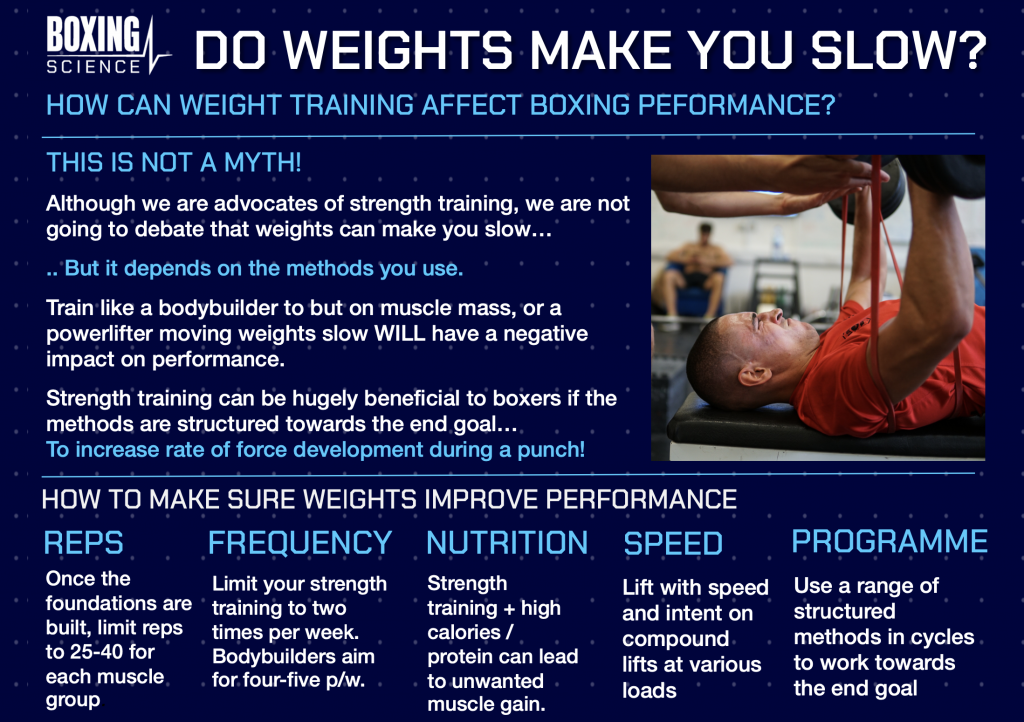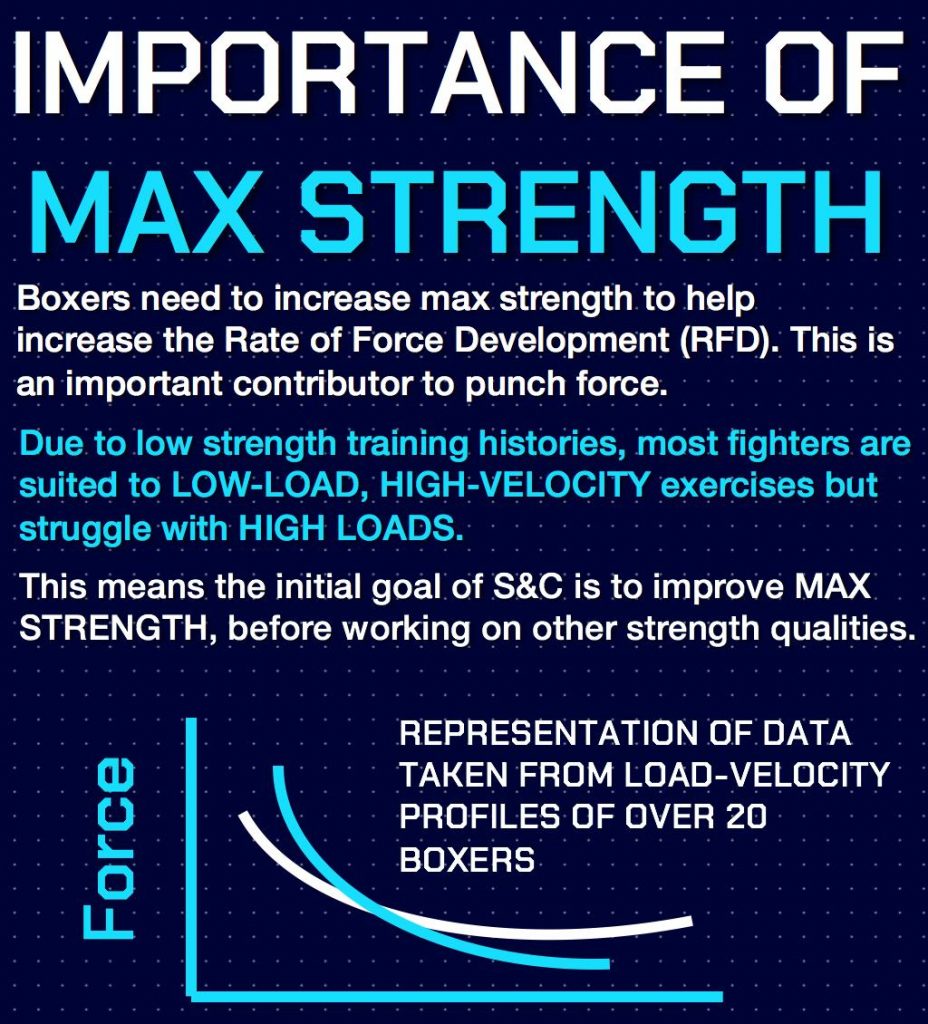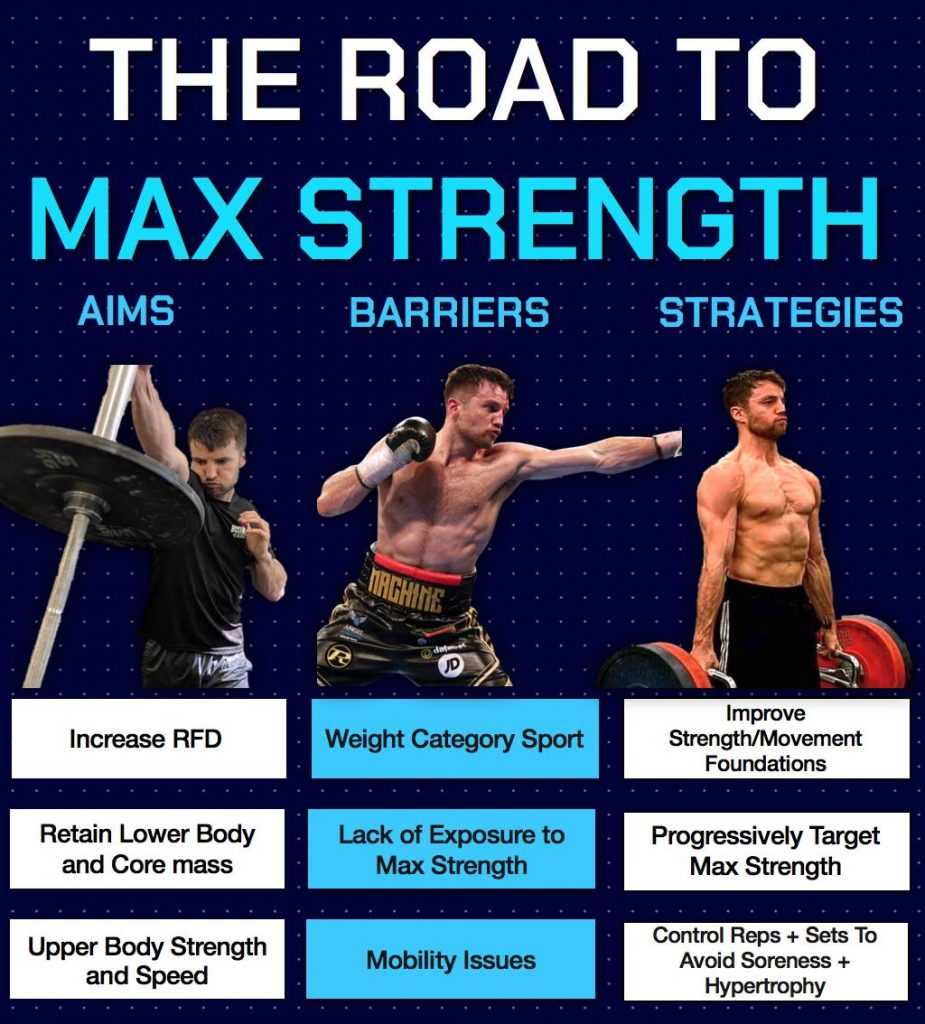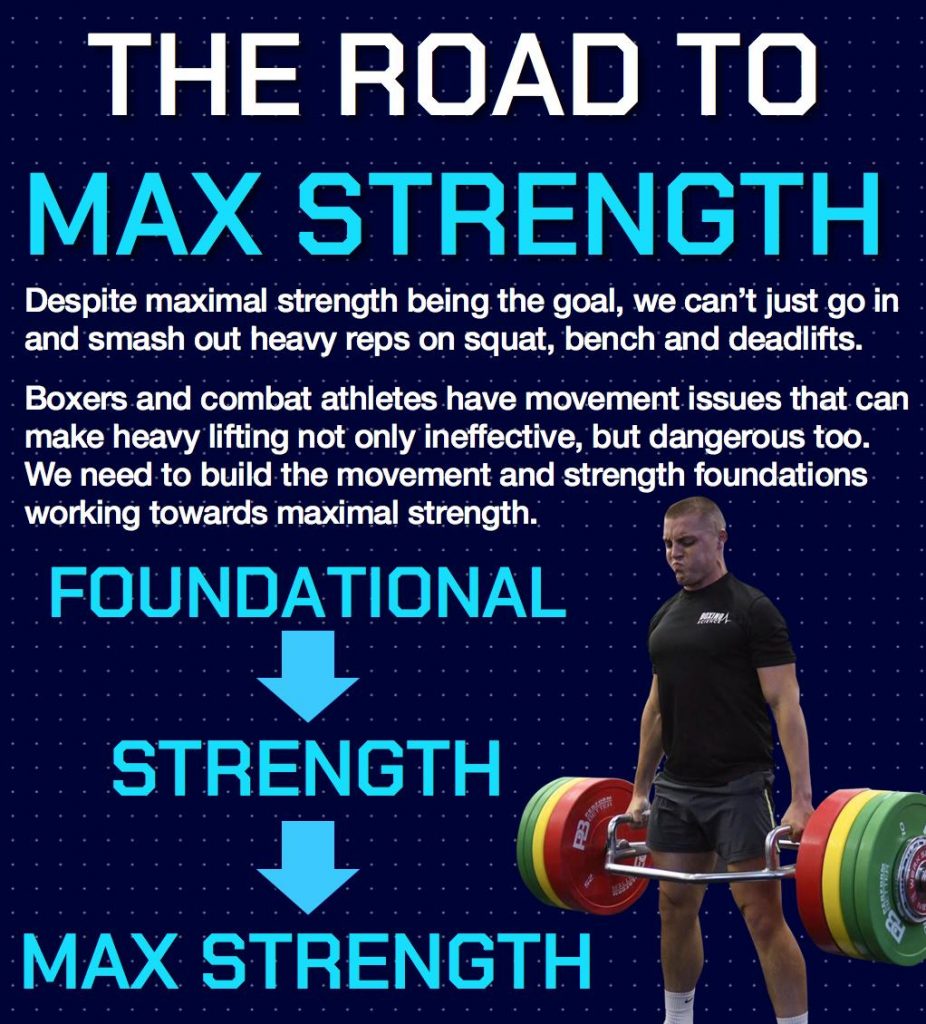S&C FOR BOXING: ROAD TO MAX STRENGTH
Many boxers are already adapted to high velocities/movement speeds due to the nature of common training methods implemented in the sport, however, these athletes tend to struggle on the opposite end of the spectrum where high forces are required.
At first glance, the strategies used to improve maximal strength seem worlds apart from the training deemed necessary to enhance a boxer’s performance in the ring. Whilst maximal strength training may lack specificity to the sport of boxing, the general adaptations gained from this type of training can have a profound impact on punch performance.
The following article will discuss:
The adaptations that lead to improvements in maximal strength.
The science behind the punch and how maximal strength adaptations transfer to improved punching power.
How to gradually expose boxers to the intensities of maximal strength without exponentially increasing injury risk.
WHAT IS MAXIMAL STRENGTH
Maximal strength can be defined as the ability to produce maximal amounts of force against external resistance, irrespective of time.
With regards to strength and conditioning this refers to the classic one repetition maximum i.e the maximal amount of weight an athlete can lift with proficient technique.
New techniques in the field of strength and conditioning to assess maximal strength levels have been developed and involve the use of maximal isometric contractions against an immovable object (Isometric mid-thigh pull)
We can also indirectly measure maximal strength capabilities through 3 and 5 rep maximum tests as well as force-velocity profiling which are deemed safer for athletes with relatively low strength training backgrounds as they are not exposed to the stresses of maximal loads.
Sports that are directly influenced by maximal strength qualities include Powerlifting, Wrestling, Strongman as well as certain aspects of Rugby and American football.
Despite playing a direct role in only a handful of sports, maximal strength training is common practice in many elite sporting pursuits.
This is because the adaptations that can be derived from maximal strength training ultimately increase an athletes overall strength potential and can have an indirect impact on speed and power qualities.

MECHANISMS UNDERPINNING MAXIMAL STRENGTH DEVELOPMENT
Maximal muscular strength is underpinned by a combination of morphological (changes in muscle structure) and neural mechanisms.
Perhaps the most well known morphological contribution to improvements in maximal strength is an increase muscular size. All else being equal, a bigger muscle is usually a stronger muscle.
Aside from increases in muscle size, other morphological adaptations to maximal strength training include changes to the arrangement of muscle fibres and increased musculotendinous stiffness.
Neural mechanisms that enhance maximal force production are increased motor unit recruitment, increased firing frequency of these motor units, improved motor unit synchronization and decreased neuromuscular inhibition.
WHAT DOES THIS MEAN FOR BOXING?
Evidently, increases in muscle size poses obvious dilemmas for a weight restricted sport such as boxing.
Therefore, as strength and conditioning coaches, the aim should be to focus on developing the neural mechanisms that contribute to improved maximal strength.
Simply, this means heavy loads lifted with maximal intent and at low volumes.

Considering the underpinning neural mechanisms of maximal strength training we can gain an understanding of how this training strategy enables athletes to fulfil their strength and power potential in subsequent training phases.
Firstly, understanding motor units will make the following points easier to digest.
A motor unit consists of a motoneuron and the muscle fibres it innervates. A Motoneuron is responsible for transferring messages from the brain and spinal cord to the muscle fibres and thus stimulating muscle contraction.
As athletes and coaches in boxing we are primarily concerned with those motor units that contain fast-twitch muscle fibers as these are responsible for high force, explosive muscle actions such as sprinting, jumping and punching.

Whether fast-twitch motor units are recruited during a movement, or not, depends on the force and speed demands of that given movement.
Higher forces needed means more fast-twitch motor unit recruitment which is ultimately the basis of maximal strength training, using relatively heavy loads to increase motor unit recruitment and thus force production.
The frequency at which these muscle fibres are stimulated is also dictated by the force and speed demands.
Performing relatively heavy lifts with maximal intent forces motoneurons to activate muscle fibres at a high rate. Greater rates of stimulation ultimately lead to more force being produced.
Exposure to high loads increases the number of motor units that are recruited at once (known as motor unit synchronisation) which, again, increases the amount of force produced.
Lastly, progressive maximal strength training decreases the influence of built-in neuromuscular protective mechanisms that limit the amount of force that can be produced at a given time.
Taking all of these neural adaptations into consideration we can see that the purpose of maximal strength training is to maximise our nervous system’s ability to produce large amounts of force.

THE SCIENCE BEHIND THE PUNCH
So, we understand that maximal strength training improves the amount of force that can be produced irrespective of the time available to produce that force.
But, how does this improve boxing performance? Specifically, how does this improve punch performance?
SIGNIFICANCE OF INCREASING FORCE PRODUCTION
The significance of improving force production capabilities is that maximal force or strength is highly associated with rate of force development i.e stronger individuals tend to produce force at a faster rate.
Rate of force development is especially relevant to the punching action as large amounts of force must be generated in short periods of time, often less than 200ms.
Through our own research we have established the importance of rate of force development, particularly from the lower body, to the punching action.
In assessing boxer’s jump heights and medicine ball punch performance we found that those who jumped higher, tended to throw the ball further.
The relationship between maximal strength and rate of force development is particularly significant for novice trainees or athletes who have not been exposed to maximal strength training previously such as boxers.
Frequently, these athlete can become more explosive and improve rate of force development by just focusing on maximal strength in the initial stages of their training.
Evidence states that this association exists up to a point, where increases in strength no longer have an impact on rate of force development.
Whilst this is certainly true for athletes who maintain a high level of strength all year round, the context of a boxer is different due to the short periods of time allocated towards maximal strength development throughout a training camp.
This means that boxers returning to training camp have significant potential to improve rate of force development through focusing on improving maximal strength once the foundations have been achieved.
TRAINING FOR MAXIMAL STRENGTH
Despite the importance of developing maximal strength for a boxer, as strength and conditioning coaches we must expose these athletes to heavy lifts gradually.
Low strength training history and movement limitations mean that we need to build quality strength and movement foundations before prescribing heavy loads.
Through years of experience in boxing we have identified the main obstacles that contra-indicate the use of maximal strength training methods with boxers.
These include boxing being a weight category sport, a lack of exposure to max strength among these athletes and mobility issues, particularly around the hips and shoulders.
To combat these issues we initially focus on establishing sound movement foundations, addressing mobility issues and limiting volume at higher loads to avoid undesirable muscle hypertrophy.

THE ROAD TO MAXIMAL STRENGTH
At boxing science we progressively target maximal strength using a phased approach that gradually exposes the athlete to higher loads and more complex movements.
These phases are known as foundational strength, strength development and then maximal strength development.
Foundational strength and strength development phases help increase the boxer’s tolerance to loading whilst also improving movement competency.

FOUNDATIONAL STRENGTH
Foundational strength phases are characterised by basic, low-loaded movement patterns and serve to ingrain solid technique whilst beginning to expose the athlete to a strength stimulus.
Strict press-ups, goblet squats and kettlebell RDLs are examples of exercises that are included in this training phase.
The volume in these phases is usually 10-12 Reps by 3-4 Sets. Whilst this may seem to be on the high side and may stimulate muscle growth its important to consider the context of a boxer.
Often boxers are trying to make weight and thus are in a negative energy balance which is not conducive to muscle growth. Furthermore the loads being lifted are light relative to their true maximum effort, therefore avoiding significant mechanical tension, a main driver of hypertrophy.
Though it is highly individually dependent, the duration in which athletes remain in the foundational phase tends to be the first 10-12 weeks of their strength and conditioning journey.

STRENGTH
These phases are characterised by slightly more complex movements that can have considerably more loading potential than the exercises prescribed in the foundational phase.
In most instances, loading is still a secondary goal to technique during these phases.
Moderate loads are performed at moderate volumes to continue learning the desired movement patterns whilst facilitating further strength development.
The main movements in this phase are usually performed for 5-8 Reps by 3-4 Sets.
Again, it could be argued that such volume would stimulate hypertrophy, however, it must be re-iterated that the presence of a calorie deficit and and use of only moderate loads would decrease the chances of muscle growth.
Examples of exercises used on this phase include the landmine squat or box squat, the floor press and Romanian deadlift. Usually athletes begin this phase once they have completed 2-3 structured strength and conditioning programs.

MAXIMAL STRENGTH
In this phase we are really targeting the neural mechanisms of strength to facilitate increased rate of force development.
Exercises in this phase can be considered the most complex and have the greatest loading potential.
3-5 Reps by 3-4 Sets are usually performed for compound lower-body lifts such as the back squat and trap-bar deadlift.
With upper-body pressing exercises we may begin at enter this phase performing 8 reps before increasing the intensity with near maximal 5 rep sets.
The emphasis during these phases is to gradually increase loads by 2.5-5kg each week to continually stimulate maximal motor unit recruitment.
These phases should only be 3-4 weeks in duration as they place a high demand on the central nervous system and may increase the chances of burnout or neural fatigue.
The back squat, horizontal upper-body press and trap-bar deadlift are commonly programmed during maximal strength phases as they allow for the greatest loads to be lifted.
Technique remains important during these phases, however, should not be too much of a concern if the previous phases have been adhered to correctly.
Consistent implementation of appropriate mobility drills and effective coaching cues should enable the athlete to lift heavy without compromising technique.

COACHING TIPS FOR MAXIMAL STRENGTH
Despite programming the necessary progressions and regressions some boxers may still display poor technique and will not be able to tolerate full range compound lifts at near maximal loads.
Additionally, with many fighters taking fights on short notice, spending the vast majority of camp on laying the foundations may not put the boxer in the best position to perform at his/her best on fight night.
Ultimately, there may come a point where its necessary to just focus on getting as strong possible in as little time as possible, but how can we do this in a safe manner without increasing the chances of injury and/or neural fatigue?
In these scenarios the following can be considered:
Implementing partial range lifts such as Anderson Squats and Trap-Bar deadlifts from blocks.
Minimising potential shear stress on joints by using the safety bar and landmine attachments.
Clustering maximal strength sets into 3 or 5 single reps with a brief pause in between. This will reduce fatigue, allow the athlete to achieve correct starting positions, integrate any coaching cues necessary, avoid any significant deviations from correct technique and maintain movement velocities throughout the set.
Adapting maximal strength phases in this way will allow the athlete to achieve high levels of strength and rate of force development without impairing technical training performance.
SUMMARY
Maximal strength development is dictated by neural and morphological mechanisms.
Due to the weight classification of boxing, targeting neural mechanisms of maximal strength development is the objective.
Increasing maximal strength can increase rate of force development, especially in athletes with lack of exposure to strength training.
At Boxing science we progressively target maximal strength using a three phased approach, including a foundational phase, a strength development phase and finally a maximal strength phase.
